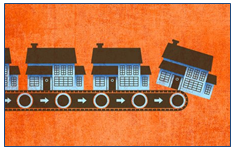ALG Editor’s Note: In the following featured column from American Enterprise Institute, Senior Fellow Peter Wallison and Resident Fellow Edward Pinto outline how the government has not learned a bloody thing from the housing bubble’s boom and bust:
By Peter Wallison and Edward Pinto
The administration has quietly shifted most federal high-risk mortgage initiatives to the government’s original subprime lender.
It is hard to believe, but it looks like the government will soon use the taxpayers’ checkbook again to create a vast market for mortgages with low or no down payments and for overstretched borrowers with blemished credit. As in the period leading to the 2008 financial crisis, these loans will again contribute to a housing bubble, which will feed on government funding and grow to enormous size. When it collapses, housing prices will drop and a financial crisis will ensue. And, once again, the taxpayers will have to bear the costs.
In doing this, Congress is repeating the same policy mistake it made in 1992. Back then, it mandated that Fannie Mae and Freddie Mac compete with the Federal Housing Administration (FHA) for high-risk loans. Unhappily for both their shareholders and the taxpayers, Fannie and Freddie won that battle.
Now the Dodd-Frank Act, which imposed far-reaching new regulation on the financial system after the meltdown, allows the administration to substitute the FHA for Fannie and Freddie as the principal and essentially unlimited buyer of low-quality home mortgages. There is little doubt what will happen then.
As in the period leading up to the 2008 financial crisis, these loans will again contribute to a housing bubble, which will feed on government funding and grow to enormous size.
Since the federal takeover of Fannie and Freddie in 2008, the government-sponsored enterprises’ (GSEs’) regulator has limited their purchases to higher-quality mortgages. Affordable housing requirements Congress adopted in 1992 and the Department of Housing and Urban Development (HUD) administered until 2008 have been relaxed. These had required Fannie and Freddie to buy the low-quality mortgages that ultimately drove them into insolvency and will cause enormous losses for the taxpayers.
The latest regulatory change does not reduce the total losses that taxpayers will suffer from HUD’s policies; those losses, estimated at about $400 billion, are baked in the cake. But the higher lending standards now required of Fannie and Freddie should reduce future losses.
Not so for the FHA. While everyone has been watching Fannie and Freddie, the administration has quietly shifted most federal high-risk mortgage initiatives to FHA, the government’s original subprime lender. Along with two other federal agencies, FHA now accounts for about 60 percent of all U.S. home purchase mortgage originations. This amounts to more than $1 trillion and is rising rapidly. The administration justifies this policy by saying it is necessary to support the mortgage market, yet borrowers are once again receiving high-risk loans.
The goal of Congress and regulators should be to foster the residential mortgage market’s return to the standards that used to prevail in 1990, before the affordable housing requirements were imposed on Fannie and Freddie. At that time, mortgages required 10 to 20 percent down payments, and were only made to borrowers with good credit and relatively low debt-to-income ratios. When loans of this kind were the standard in the residential mortgage market, we did not have financial crises brought on by the collapse of a housing bubble.
The latest regulatory change does not reduce the total losses that the taxpayers will suffer from HUD’s policies; those losses, estimated at about $400 billion, are baked in the cake.
The Dodd-Frank Act, however, exempts FHA and other government agencies from appropriate standards on mortgage quality. This will give low-quality mortgages a direct route into the market once again; it will be like putting Fannie and Freddie back in the same business, but with an explicit government guarantee.
For example, thanks to expanded government lending, 60 percent of home purchase loans now have down payments of less than 5 percent, compared to 40 percent at the height of the bubble, and the FHA projects that it will increase its insured loans total to $1.34 trillion by 2013. Indeed, the FHA just announced its intention to push almost half of its home purchase volume into subprime territory by 2014-2017, essentially a guarantee to put taxpayers at risk again.
What is the answer? The Dodd-Frank Act needs significant amendment, so that it applies quality standards to FHA and other government agencies. This should not seriously impair credit availability for low-income borrowers with good credit. For many years, until it had to compete with Fannie and Freddie for affordable loans, FHA had reasonably good standards for the mortgages it would insure. As late as 1990, only 4 percent of the loans it insured had down payments of 3 percent or less, though by 2008 this number was 44 percent.
Establishing reasonable lending standards for the FHA, while still allowing it to make loans to low-income borrowers, would assure that the agency does not become the unworthy successor to Fannie and Freddie.
Dodd-Frank was badly designed in numerous ways. Many observers have noted that it did not address the government housing policies that caused the financial crisis. A first order of business for the new Congress should be to correct this error by requiring that the FHA and other government mortgage lenders abide by reasonable mortgage lending standards.
Peter J. Wallison is a senior fellow and Edward J. Pinto is a resident fellow at the American Enterprise Institute.




